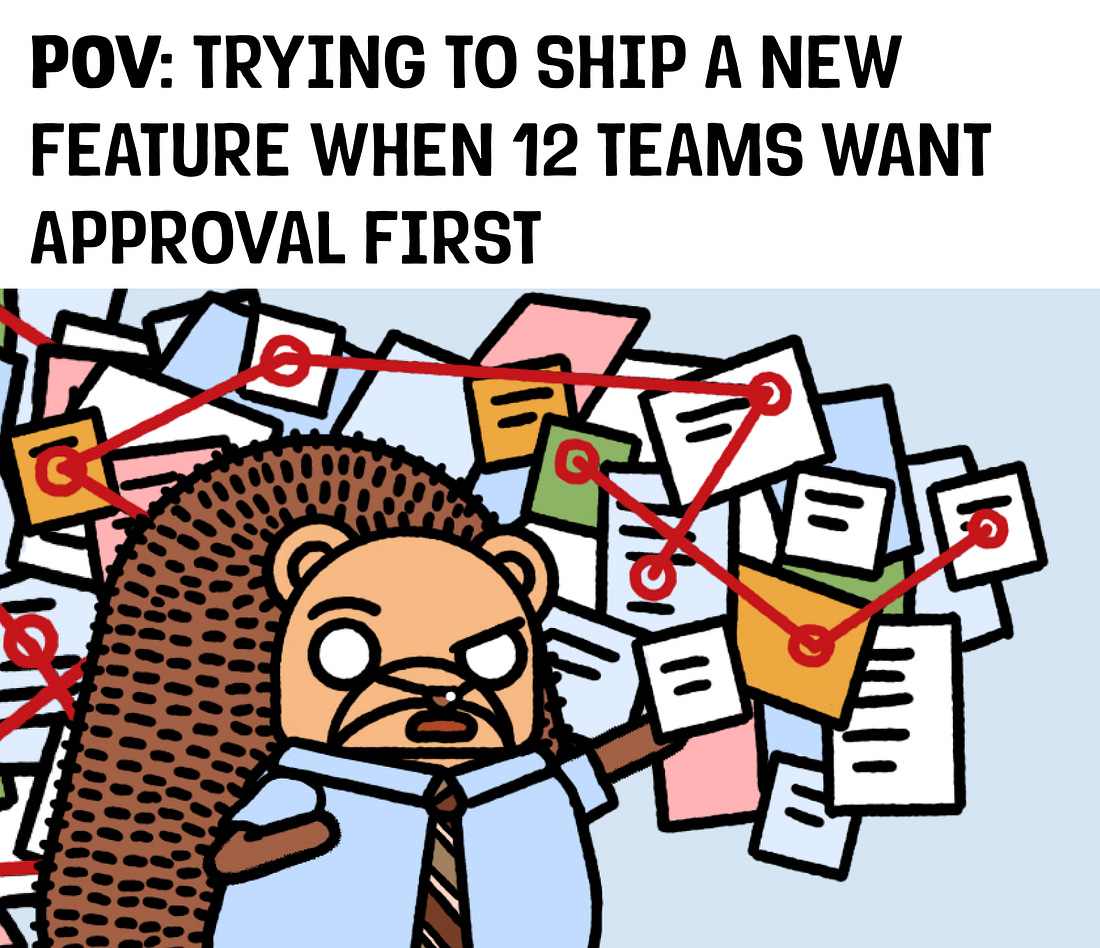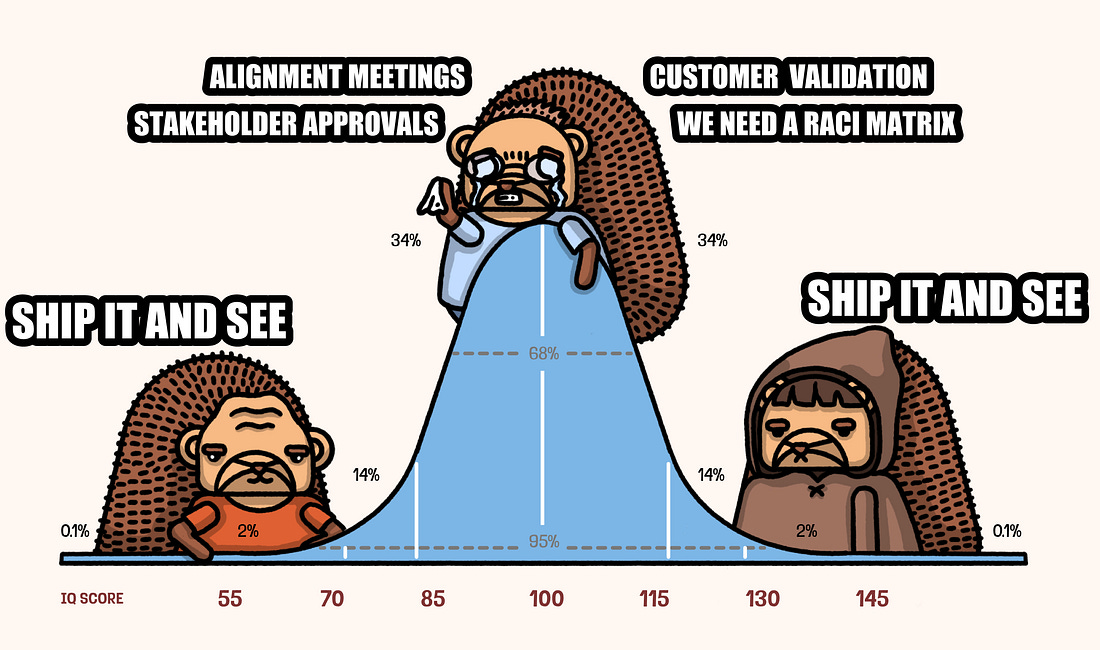This is why you're not shipping
Many years ago, I had a boss who lived in meetings. Our only meaningful interaction was the 30 minutes around lunchtime when they'd sit at their desk and pepper me with questions while circumnavigating a salad:
I wasn't alone. Everyone who did my job had the same relationship with their boss. There were entire layers of people at this company who just went from meeting-to-meeting all day.¹ This 1% dictated the pace for everyone else, so everything moved slowly. Here's how to spot the signs and avoid this fate. 1. You wait for 1:1 meetings to solve problemsWe all encounter problems in our work. Uncertainty, technical blockers, interpersonal conflicts, skill issues: take your pick. People often use 1:1s with their manager to deal with these, so problems fester until the next opportunity to chat. This is bad on an individual level, but catastrophic when 200 or so people are all doing the same thing. A compounding, bloated tumor of procrastination. Just like giving feedback, the best time to deal with any problem is the moment you encounter it. What we doWe encourage people to have fewer 1:1s. They should be far enough away that waiting until your next one would feel totally wrong. Also, rethink how you use them. If it's just to update your manager, something is wrong. This should happen transparently, so everyone has the context. Instead, use them to brainstorm, plant the seed of an idea before sharing it more widely, and get feedback on where you can do better. If 1:1s become just about problems you have, they become a chore that no one enjoys. 2. You need another team to approve your workThis can happen for all sorts of reasons:
The reason is less important than the impact. Every time you go outside your team to move forward, you're adding latency. And, just like 1:1s, the impact of this latency compounds as a company grows until it becomes impossible to move at speed. What we doThis is a hard problem to solve from the bottom up: it has to come from the top. At PostHog, we solve for this in a few different ways:
This is what works for us, but it goes hand-in-hand with solving another red flag... 3. Teams and ownership are hard to changeIt's hard to move fast when the wrong team owns a problem. They become a bottleneck, either by blocking people who want to fix it, or by slowing things down through excessive coordination and approvals. It's even harder to move fast when ownership problems become insoluble. People learn to avoid things that other teams own, so they go unsolved and get worse. What we doWe've talked about how small teams ship faster before, but there's another important benefit: they're easy to change. Whenever a team gets too big, or it makes sense to form a new one to achieve a goal, we just do it. Typically, the process looks something like this: A few months ago, for example, we created one team to own both event ingestion and building our customer data platform and realtime destinations. This made sense because the two systems needed to work well together. Recently, however, we've split them into two separate teams again: Ingestion and CDP. Why? Because the problem has moved from "how do we make this work?" to "we need to build more integrations". We also maintain a public feature ownership doc that anyone can propose changes to at any time through a PR. Who owns what isn't dictated solely by leadership. 4. Sales outnumbers engineeringIt's basically impossible to ship fast in a sales-led company. You become stuck fulfilling their unrealistic promises. In fact, while shipping fast is an advantage, especially for startups, it isn't appropriate in every type of company. So, if you want to join a team that ships fast, avoid companies where sales people outnumber product people or engineers, or even those with a near 1:1 ratio. What we doPostHog currently comprises 91 people, the vast majority of whom have "engineer" in their job title. We also:
5. You actively keep people “in the loop”Having to actively push information to other people is a sure sign that keeping people aligned is more important than doing the thing. It means you have to:
This is busy work that slows you down. What we doAs is often the case, we solve this through transparency. Everything we do is out in the open. Team goals. Product revenue. Growth reviews. Sprint issues. The decisions people make and why. It’s all out there. This makes us faster because it forces individuals to decide for themselves if they need to stay informed, and lets them pull the context they need from what's free for all to see. If transparency is the answer, how do you make this happen in a company where it isn't the norm? Here's a good way to start:
Your goal here is to train people in how you want to work, and hopefully convince others to do the same. For inspiration, here are some examples from PostHog:
6. Average performers never leavePeople who are obviously bad at their jobs are rarely the problem. They're easy to spot and easy to remove, the real problems come from:
They both slow you down by needing more oversight, or by not being ambitious enough. Being 10/10 all the time isn't realistic, but moving fast requires a consistently higher level of performance. What we doFirst, we regularly apply the keeper test, which has three key points:
Second, we act decisively when someone isn't meeting expectations. This means explicitly telling them they're falling short, and what good performance looks like. If change isn't forthcoming within a few weeks, we let them go immediately and give them a generous severance. We avoid performance improvement plans because it's demeaning for those affected, and excessively time consuming for managers. 7. Progress feels predictable and comfortableShipping fast should feel a little dangerous, chaotic, and scary sometimes. It's an anti-pattern to want complete consensus, or control. Disagreements will happen. Ultimately, speed is a deliberate choice with clear tradeoffs. We know, for example, that the first version of something we ship won't be the most polished. We know we'll take a wrong path sometimes. We accept this because shipping fast gets us information from our users, and the market, more quickly than shipping perfect. TL;DR: The faster we learn, the faster our product improves. Speed, like talent, compounds. Words by Andy Vandervell, who wrote this article quite slowly, actually. 🌶️ Spicy reads not written by AI1 It’s important to point out that my boss wasn’t at fault here. This culture had developed for over a decade. It had an irresistible gravity that sucked everyone in, like the black hole in Interstellar but without the epic soundtrack. All a single person could do was paddle hard and hope they could achieve escape velocity. 🚀 |
Similar newsletters
There are other similar shared emails that you might be interested in:



